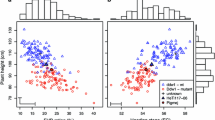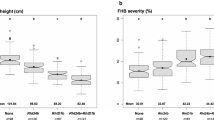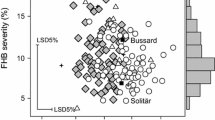Summary
Differences in levels of resistance toSeptoria tritici blotch were observed in plants with a specific height-reducing gene. When the gene ‘Rht 2’ was present either as an isoline or in the progeny, a higher degree of resistance was found. The most susceptible plants were observed in populations carrying the ‘Rht 1’ gene. Associations, as determined by phenotypic correlations, were detected betweenSeptoria tritici blotch and tall stature, late heading, and maturity. Plants having short stature, early heading, early maturity, and acceptable levels of resistance were identified in the F2 population whenRht 2 was present. Results of this study indicated that wheat breeders must select the appropriate dwarfing source that may confer resistance and grow large F2 populations, in order to increase the probability of obtaining desired genotypes.
Similar content being viewed by others
References
Allan RE, Pritchett JA (1982) Registration of 16 lines of hard red winter wheat germplasm. Crop Sci 22:903–904
Bahat A, Gerlernter I, Brown MB, Eyal Z (1980) Factors affecting the vertical progression ofSeptoria leaf blotch in short statured wheats. Phytopathology 70:179–184
Danon T, Sacks JM, Eyal Z (1982) The relationships among plant stature, maturity class, and susceptibility toSeptoria leaf blotch of wheat. Phytopathology 72:1037–1042
Eyal Z (1981) Integrated control ofSeptoria diseases of wheat. Plant Dis 65:763–768
Eyal Z, Wahl I, Prescott JM (1983) Evaluation of germplasm response toSeptoria leaf blotch of wheat. Euphytica 32:439–446
Eyal Z, Scharen AL, Prescott JM, Van Ginkel M (1987) TheSeptoria disease of wheat: A practical introduction to disease management. CIMMYT, Mexico City
Gale MD, Youssefian S (1985) Dwarfing genes of wheat. In: Russell GE (ed) Progress in plant breeding-1. Butterworth, London, pp 1–35
Gale MD, Marshall GA, Rao MV (1981) A classification of the Norin 10 and Tom thumb dwarfing genes in British, Mexican, Indian, and other hexaploid bread wheat varieties. Euphytica 30:355–361
Mann CE, Rajaram S, Villareal RL (1985) Progress in breeding forSeptoria tritici resistance in semidwarf spring wheat at CIMMYT. In: Scharen AL (ed)Septoria of Cereals Proceedings Workshop, August 2–4, 1983, Bozeman/MT, USDAARS Publication No. 12:2–26
Rajaram S, Dubin HJ (1977) Avoiding genetic vulnerability in semi-dwarf wheats. Ann NY Acad Sci 287:243–254
Rosielle AA, Boyd WJR (1985) Genetics of host-pathogen interactions to theSeptoria species of wheat. In: Scharen AL (ed)Septoria of Cereals Proceedings Workshop, August 2–4, 1983, Bozeman/MT, USDA-ARS Publication No. 12:9–12
Rosielle AA, Brown AGP (1979) Inheritance, heritability, and breeding behavior of three sources of resistance toSeptoria tritici in wheat. Euphytica 28:385–392
Saadaoui EM (1987) Physiological specialization ofSeptoria in Morocco. Plant Dis 71:153–155
Saari EE, Wilcoxson RD (1974) Plant disease situation of highyielding dwarf wheats in Asia and Africa. Annu Rev Phytopathol 12:49–68
Scott PR, Benedikz PW (1985) The effect of Rht2 and other height genes on resistance toSeptoria nodorum andSeptoria tritici in wheat. In: Scharen AL (ed)Septoria of Cereals Proceedings Workshop, August 2–4, 1983, Bozeman/MT, USDA-ARS Publication No. 12:18–21
Scott PR, Benedikz PW, Cox CJ (1982) A genetic study of the relationship between height, time of ear emergence, and resistance toSeptoria nodorum in wheat. Plant Pathol 31:45–60
Scott PR, Benedikz PW, Jones HG, Ford MA (1985) Some effects of canopy structure and microclimate on infection of tall and short wheats bySeptoria nodorum. Plant Pathol 34:578–593
Shaner G, Finney RE, Patterson FL (1975) Expression and effectiveness of resistance in wheat toSeptoria leaf blotch. Phytopathology 65:761–766
Tavella CM (1978) Date of heading and plant height of wheat varieties, as related toSeptoria leaf blotch damage. Euphytica 27:577–580
Author information
Authors and Affiliations
Additional information
Communicated by G. Wenzel
Rights and permissions
About this article
Cite this article
Baltazar, B.M., Scharen, A.L. & Kronstad, W.E. Association between dwarfing genes ‘Rht1’ and ‘Rht2’ and resistance toSeptoria tritici Blotch in winter wheat (Triticum aestivum L. em Thell). Theoret. Appl. Genetics 79, 422–426 (1990). https://doi.org/10.1007/BF01186089
Received:
Accepted:
Issue Date:
DOI: https://doi.org/10.1007/BF01186089




